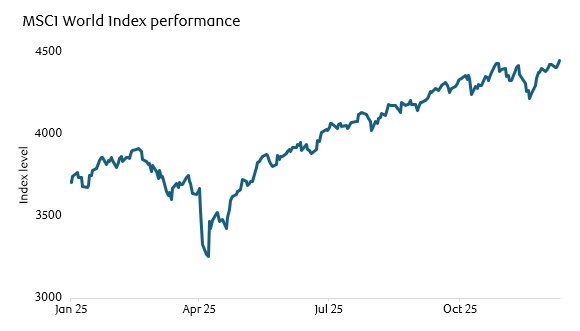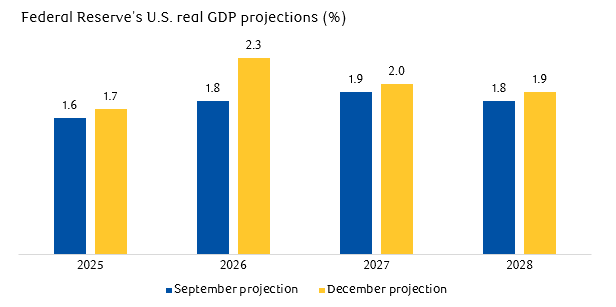Equities soar to record highs
Views & insightsGlobal stocks outperformed last week, driven largely by the Federal Reserve’s third consecutive rate cut.
Download Markets in a Minute PDF
Key highlights
- The Fed cuts: Global equities reached record highs as the Federal Reserve (the Fed) rate cut and upgraded U.S. growth forecasts supported a broadening market rally.
- AI capex concerns: Technology stocks lagged last week, reflecting concerns over AI capital expenditure (capex) and stretched valuations.
- Weak UK GDP: Last week provided yet more evidence of weak UK economic growth, reinforcing expectations of a Bank of England (BoE) rate cut this week.
Fed rate cut and growth upgrade support market sentiment
Global equity markets reached record highs last week, with gains broadening beyond the largest technology names.

Source: Bloomberg
Support has come from a third consecutive interest rate cut by the Fed, alongside an upward revision to its growth forecasts, reinforcing its confidence in the economic outlook. This combination has helped broaden the rally in the U.S. equity market beyond the usual AI darlings.
Meanwhile, markets are becoming more critical of the scale of capex into AI and the stretched valuations across parts of the AI ecosystem. Concerns are particularly focused on the capability of those laden with high debt to finance infrastructure build outs.
The focus last week was the Fed’s latest decision for a widely expected rate cut. More important than the move itself was the message from the updated projections. The Fed revised its growth outlook higher, reflecting resilience in domestic demand, and it continues to expect the labour market to remain relatively steady. Inflation forecasts for next year were revised modestly lower, but policymakers still don’t expect inflation to return to target until 2028. This highlights that the final stage of disinflation is likely to be gradual rather than straightforward.

Source: The Federal Open Market Committee
That guidance also highlights the limits to further easing. The Fed’s projections point to just one additional rate cut in 2026, compared with market expectations of closer to two cuts. This suggests there’s limited scope for rate expectations to fall much further – unless the data weakens materially. This has fuelled debate around how much policy support the economy actually needs if growth remains firm.
Speculation continues regarding the future leadership of the Fed, with some assuming that a chair appointed by President Donald Trump could lean more dovish. However, the chair is only one of twelve voting members on the Federal Open Market Committee, and policy outcomes ultimately reflect the balance of views across the committee. Recent projections suggest this balance remains cautious rather than aggressively accommodative.
Concerns over AI capex
Against the backdrop of improved market sentiment, technology stocks underperformed last week, even as interest rates moved lower. Ordinarily, easier financial conditions would support valuations across growth sectors. Instead, the relative weakness reflects elevated valuations and growing investor unease around the scale and returns of capex tied to AI.
One example is cloud computing provider Oracle, an important player in the AI data centre build-out. Despite a strong pipeline from its AI business, Oracle shares fell sharply after the company signalled a significant increase in capital spending. Investors are scrutinising Oracle because it’s taken out significant debt to fund its ambitions. Investors are concerned about its balance sheet pressure, the long lead time before revenues fully materialise, and its worsening credit quality. In short, despite strong orders and promising prospects, there are signs that investors are getting impatient for AI’s return on investment.
Meanwhile, chip designer Broadcom delivered another strong set of results and reaffirmed robust AI demand. Yet its shares failed to excite investors, partly because expectations were already high following a strong rally this year. These moves don’t suggest the AI theme is fading, but they do indicate that markets are becoming more disciplined, with a sharper focus on execution, corporate leverage, free cash flows, and valuations, rather than exciting headlines or headline demand growth. These moves reinforce the importance of diversification and selectivity in the current environment.
Weak UK GDP supports Bank of England rate decision
Turning to the UK, the latest economic data reinforces the picture of a stagnant economy. Gross domestic product (GDP) contracted by 0.1% in October, and on a three-month-on-three-month basis (May to July vs August to October), output was also down 0.1%.

Source: Bloomberg
In fact, the UK economy has expanded in just one of the past seven months, underlining how fragile growth has become. The weakness has been broad-based, particularly across services sectors such as retail and construction, reflecting ongoing pressures on household spending and cautious business behaviour.
Some of this softness may reflect uncertainty ahead of the Autumn Budget, as firms and households delayed decisions in the face of potential tax changes. However, the medium-term outlook remains challenging.
Further tax rises are expected over the coming years, which risk weighing on consumption and investment at a time when growth is already struggling to gain traction. This leaves the UK economy vulnerable to prolonged stagnation rather than a clear recovery.
Encouragingly, UK inflation dynamics are moving in a more favourable direction. The Bank of England (BoE)’s latest survey shows a further easing in households’ inflation expectations, suggesting that underlying price pressures are expected to become more manageable. Combined with weak growth momentum and a peak in inflation, this provides a substantive argument for policy easing.
Against this backdrop, the case for a BoE rate cut at its next meeting has strengthened and is now mostly priced in by markets.
Coming up
- Central bank decisions: The BoE, European Central Bank (ECB) and Bank of Japan (BoJ) will deliver policy decisions. The BoE is expected to cut, the ECB to stay put and the BoJ to hike.
- U.S. inflation and jobs update: We’ll get a fresh view of the state of the U.S. economy with the release of the delayed U.S. Consumer Price Index (CPI) for November and jobs report for October (partial release)/November.
- Global purchasing manager indices: These reputable private sector business surveys will provide the latest update on the global economy as 2025 concludes.
The value of investments, and any income from them, can fall and you may get back less than you invested. Neither simulated nor actual past performance are reliable indicators of future performance. Investment values may increase or decrease as a result of currency fluctuations. Information is provided only as an example and is not a recommendation to pursue a particular strategy. Information contained in this document is believed to be reliable and accurate, but without further investigation cannot be warranted as to accuracy or completeness. Forecasts are not a reliable indicator of future performance. We or a connected person may have positions in or options on the securities mentioned herein or may buy, sell or offer to make a purchase or sale of such securities from time to time. For further information, please refer to our conflicts policy which is available on request or can be accessed via our website at www.brewin.co.uk.